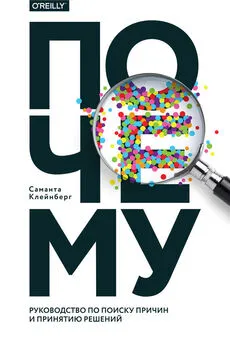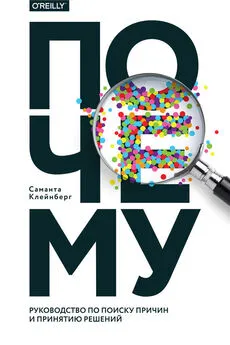Саманта Клейнберг - Почему
- Название:Почему
- Автор:
- Жанр:
- Издательство:Литагент МИФ без БК
- Год:2017
- Город:Москва
- ISBN:978-5-00100-593-3
- Рейтинг:
- Избранное:Добавить в избранное
-
Отзывы:
-
Ваша оценка:
Саманта Клейнберг - Почему краткое содержание
Книга будет интересна аналитикам, философам, исследователям, медикам, экономистам, юристам, начинающим ученым, всем, кто имеет дело с массивами данных и хочет научиться критическому мышлению.
На русском языке публикуется впервые.
Почему - читать онлайн бесплатно полную версию (весь текст целиком)
Интервал:
Закладка:
Fischer, D. A. (1992). Causation in Fact in Omission Cases. Utah Law Review , pp. 1335–1384.
Fischer, D. A. (2006). Insufficient Causes. Kentucky Law Journal , 94: 277–37.
Fisher, R. A. (1925). Statistical Methods for Research Workers . Oliver and Boyd, Edinburgh.
Fitelson, B. and Hitchcock, C. (2011). Probabilistic measures of causal strength. In P. M. Illari, F. Russo, and J. Williamson (eds.), Causality in the Sciences , pp. 600–627. Oxford University Press, Oxford.
Fleming, P. J., Blair, P., Bacon, P., and Berry, J. (eds.) (2000). Sudden unexpected deaths in infancy: The CESDI SUDI studies 1993–1996 . The Stationery Office, London.
Fowler, J. H. and Dawes, C. T. (2008). Two Genes Predict Voter Turnout. The Journal of Politics , 70(3): 579–594.
Frank, S. A., Wilson, R., Holloway, R. G., Zimmerman, C., Peterson, D. R., Kieburtz, K., and Kim, S. Y. H. (2008). Ethics of sham surgery: Perspective of patients. Movement Disorders , 23(1): 63–68.
Freedman, D. and Humphreys, P. (1999). Are There Algorithms That Discover Causal Structure? Synthese , 121(1–2): 29–54.
Fugelsang, J. A. and Thompson, V. A. (2003). A dual-process model of belief and evidence interactions in causal reasoning. Memory & Cognition , 31(5): 800–815.
Fumerton, R. and Kress, K. (2001). Causation and the Law: Preemption, Lawful Sufficiency, and Causal Sufficiency. Law and Contemporary Problems , 64(4): 83–105.
Gabriel, A. and Mercado, C. P. (2011). Data retention after a patient withdraws consent in clinical trials. Open Access Journal of Clinical Trials , 3: 15–19.
Gemelli, A. and Cappellini, A. (1958). The influence of the subject’s attitude in perception. Acta Psychologica , 14: 12–23.
Ginsberg, J., Mohebbi, M. H., Patel, R. S., Brammer, L., Smolinski, M. S., and Brilliant, L. (2009). Detecting influenza epidemics using search engine query data. Nature , 457: 1012–1014.
Glasgow, R. E., Lichtenstein, E., and Marcus, A. C. (2003). Why Don’t We See More Translation of Health Promotion Research to Practice? Rethinking the Efficacy-to-Effectiveness Transition. American Journal of Public Health , 93(8): 1261–1267.
Glennan, S. (1996). Mechanisms and the Nature of Causation. Erkenntnis , 44(1): 49–71.
Glennan, S. (2002). Rethinking Mechanistic Explanation. Philosophy of Science , 69(3): S342–S353.
Godfrey-Smith, P. (2010). Causal Pluralism. In H. Beebee, C. R. Hitchcock, and P. Menzies (eds.), Oxford Handbook of Causation , pp. 326–337. Oxford University Press, Oxford.
Goldman, D. P., Joyce, G. F., and Zheng, Y. (2007). Prescription Drug Cost Sharing: Associations With Medication and Medical Utilization and Spending and Health. Journal of the American Medical Association , 298(1): 61–69.
Good, I. J. (1961). A Causal Calculus (I). British Journal for the Philosophy of Science , 11(44): 305–318.
Gopnik, A., Sobel, D. M., Schulz, L. E., and Glymour, C. (2001). Causal Learning Mechanisms in Very Young Children: Two-, Three-, and Four-Year-Olds Infer Causal Relations From Patterns of Variation and Covariation. Developmental Psychology , 37(5): 620–629.
Gopnik, A., Glymour, C., Sobel, D. M., Schulz, L. E., Kushnir, T., and Danks, D. (2004). A Theory of Causal Learning in Children: Causal Maps and Bayes Nets. Psychological Review , 111(1): 3–32.
Granger, C. W. J. (1980). Testing for Causality: A Personal Viewpoint. Journal of Economic Dynamics and Control , 2: 329–352.
Green, J. (2012). The Science Behind Those Obama Campaign E-Mails. Bloomberg Businessweek . Retrieved from http://www.businessweek.com/articles/2012-11-29/the-science-behind-those-obama-campaign-e-mails .
Greville, W. J. and Buehner, M. J. (2010). Temporal Predictability Facilitates Causal Learning. Journal of Experimental Psychology: General , 139(4): 756–771.
Griffiths, T. L., Sobel, D. M., Tenenbaum, J. B., and Gopnik, A. (2011). Bayes and Blickets: Effects of Knowledge on Causal Induction in Children and Adults. Cognitive Science , 35(8): 1407–1455.
Griffiths, T. L. and Tenenbaum, J. B. (2005). Structure and strength in causal induction. Cognitive Psychology , 51(4): 334–384.
Grodstein, F., Stampfer, M. J., Colditz, G. A., Willett, W. C., Manson, J. E., Joffe, M., Rosner, B., Fuchs, C., Hankinson, S. E., Hunter, D. J., Hennekens, C. H., and Speizer, F. E. (1997). Postmenopausal Hormone Therapy and Mortality. The New England Journal of Medicine , 336(25): 1769–1775.
Groves, R. M., Fowler Jr., F. J., Couper, M. P., Lepkowski, J. M., Singer, E., and Tourangeau, R. (2009). Survey Methodology , 2nd edition. John Wiley & Sons, Hoboken, NJ 2nd edition.
Grünbaum, A. (1981). The placebo concept. Behaviour Research and Therapy , 19(2): 157–167.
Grzegorczyk, M. and Husmeier, D. (2009). Non-stationary continuous dynamic Bayesian networks. In Proceedings of the 23rd Annual Conference on Neural Infor-mation Processing Systems .
Guyatt, G. H., Oxman, A. D., Vist, G. E., Kunz, R., Falck-Ytter, Y., Alonso-Coello, P., and Schünemann, H. J. (2008). GRADE: An emerging consensus on rating quality of evidence and strength of recommendations. BMJ , 336(7650): 924–926.
Gweon, H. and Schulz, L. (2011). 16-Month-Olds Rationally Infer Causes of Failed Actions. Science , 332(6037): 1524.
Hajjar, E. R., Cafiero, A. C., and Hanlon, J. T. (2007). Polypharmacy in elderly patients. The American Journal of Geriatric Pharmacotherapy , 5(4): 345–351.
Halpern, J. Y. and Hitchcock, C. R. (2010). Actual Causation and the Art of Modeling. In R. Dechter, H. Geffner, and J. Y. Halpern (eds.), Heuristics, Probability and Causality: A Tribute to Judea Pearl , pp. 383–406. College Publications, London.
Hanushek, E. A. (2011). The economic value of higher teacher quality. Economics of Education Review , 30(3): 466–479.
Hart, H. L. A. and Honoré, T. (1985). Causation in the Law . Oxford University Press, Oxford.
Haskins, R. and Sawhill, I. V. (2009). Creating an Opportunity Society . Brookings Institution Press, Washington, DC.
Hastie, R. and Pennington, N. (1996). The O. J. Simpson Stories: Behavioral Scientists’ Reflections on The People of the State of California v. Orenthal James Simpson. University of Colorado Law Review , 67: 957–976.
Haushofer, J. and Shapiro, J. (2013). Household response to income changes: Evidence from an unconditional cash transfer program in Kenya. Technical report.
Hausman, D. M. (2005). Causal Relata: Tokens, Types, or Variables? Erkenntnis , 63(1): 33–54.
Heeger, D. J. and Ress, D. (2002). What does fMRI tell us about neuronal activity? Nature Reviews Neuroscience , 3(2): 142–151.
Heider, F. and Simmel, M. (1944). An Experimental Study of Apparent Behavior. The American Journal of Psychology , 57(2): 243–259.
Henning, A. S. (1948). Dewey defeats Truman. Chicago Tribune , November: p. 1.
Henrich, J., Heine, S. J., and Norenzayan, A. (2010). The weirdest people in the world? Behavioral and Brain Sciences , 33(2–3): 61–83.
Heres, S., Davis, J., Maino, K., Jetzinger, E., Kissling, W., and Leucht, S. (2006). Why Olanzapine Beats Risperidone, Risperidone Beats Quetiapine, and Quetia-pine Beats Olanzapine: An Exploratory Analysis of Head-to-Head Comparison Studies of Second-Generation Antipsychotics. American Journal of Psychiatry , 163(2): 185–194.
Hernan, M. A., Clayton, D., and Keiding, N. (2011). The Simpson’s paradox unraveled. International Journal of Epidemiology , 40(3): 780–785.
Herndon, T., Ash, M., and Pollin, R. (2014). Does high public debt consistently stifle economic growth? A critique of Reinhart and Rogoff. Cambridge Journal of Economics , 38(2): 257–279.
Hill, A. B. (1965). The Environment and Disease: Association or Causation? Proceedings of the Royal Society of Medicine , 58(5): 295–300.
Hitchcock, C. and Knobe, J. (2009). Cause and norm. Journal of Philosophy , 106(11): 587–612.
Hitchcock, C. R. (1995). The Mishap at Reichenbach Fall: Singular vs. General Causation. Philosophical Studies , 78(3): 257–291.
Ho, Y. C. and Pepyne, D. L. (2002). Simple Explanation of the No-Free-Lunch Theorem and Its Implications. Journal of Optimization Theory and Applications , 115(3): 549–570.
Höfer, T., Przyrembel, H., and Verleger, S. (2004). New evidence for the Theory of the Stork. Paediatric and Perinatal Epidemiology , 18(1): 88–92.
Höfler, M. (2005). The Bradford Hill considerations on causality: A counterfactual perspective. Emerging Themes in Epidemiology , 2: 11.
Holgate, S. T., Komaroff, A. L., Mangan, D., and Wessely, S. (2011). Chronic fatigue syndrome: Understanding a complex illness. Nature Reviews Neuroscience , 12(9): 539–544.
Holson, L. M. (2009). Putting a Bolder Face on Google. The New York Times , February: p. B1.
Holyoak, K. J. and Cheng, P. W. (2011). Causal Learning and Inference as a Rational Process: The New Synthesis. Annual Review of Psychology , 62: 135–163.
Howick, J. (2011). Placebo Controls: Problematic and Misleading Baseline Measures of Effectiveness , pp. 80–95. Wiley-Blackwell, Chichester, West Sussex, UK.
Howick, J., Chalmers, I., Glasziou, P., Greenhalgh, T., Heneghan, C., Liberati, A., Moschetti, I., Phillips, B., and Thornton, H. (2011). Explanation of the 2011 Oxford Centre for Evidence-Based Medicine (OCEBM) Levels of Evidence (Back-ground Document).
Howick, J., Glasziou, P., and Aronson, J. K. (2009). The evolution of evidence hierarchies: What can Bradford Hill’s ‘guidelines for causation’ contribute? The Journal of the Royal Society of Medicine , 102(5): 186–194.
Hripcsak, G., Elhadad, N., Chen, Y. H., Zhou, L., and Morrison, F. P. (2009). Using Empiric Semantic Correlation to Interpret Temporal Assertions in Clinical Texts. Journal of the American Medical Informatics Association , 16(2):220–227.
Hué, S., Gray, E. R., Gall, A., Katzourakis, A., Tan, C. P., Houldcroft, C. J., McLaren, S., Pillay, D., Futreal, A., and Garson, J. A. (2010). Disease-associated XMRV sequences are consistent with laboratory contamination. Retrovirology , 7(1): 111.
Hulley, S., Grady, D., Bush, T., Furberg, C., Herrington, D., Riggs, B., and Vittinghoff, E. (1998). Randomized Trial of Estrogen Plus Progestin for Secondary Prevention of Coronary Heart Disease in Postmenopausal Women. JAMA , 280(7): 605–613.
Hume, D. (1739). A Treatise of Human Nature . London. Reprint, Prometheus Books, 1992. Citations refer to the Prometheus edition.
Hume, D. (1748). An Enquiry Concerning Human Understanding . London. Reprint, Dover Publications, 2004.
Illari, P. and Russo, F. (2014). Causality: Philosophical Theory Meets Scientific Practice . Oxford University Press, Oxford.
Issenberg, S. (2012). The Victory Lab: The Secret Science of Winning Campaigns . Crown, New York.
Jepsen, C. and Rivkin, S. (2009). Class Reduction and Student Achievement: The Potential Tradeoff between Teacher Quality and Class Size. Journal of Human Resources , 44(1): 223–250.
Johnson, S. R. (2008). The Trouble with QSAR (or How I Learned To Stop Worrying and Embrace Fallacy). Journal of Chemical Information and Modeling , 48(1): 25–26.
Читать дальшеИнтервал:
Закладка:






![Саманта Даунинг - Моя дорогая жена [litres]](/books/1070823/samanta-dauning-moya-dorogaya-zhena-litres.webp)



